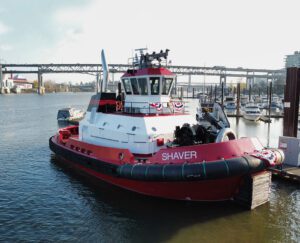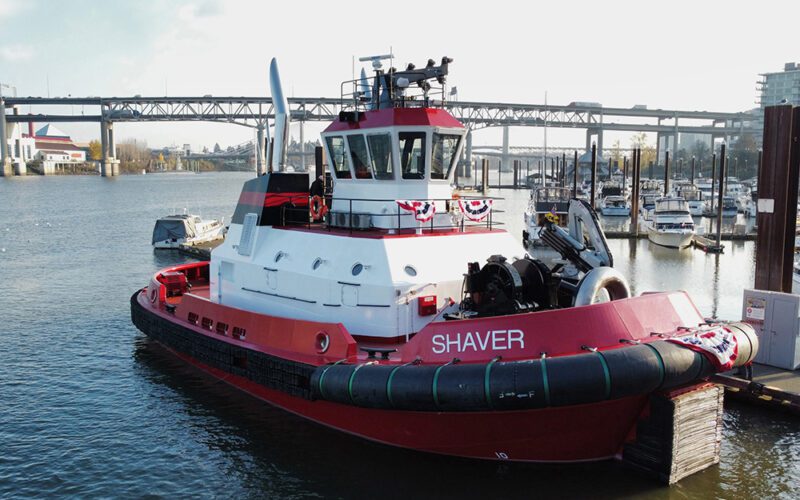
Shaver Transportation, which provides ship handling services at all the ports of the lower Columbia River and barge hauling services down the Columbia-Snake River system, has been operating tugs on the Columbia since 1880 when its sternwheel steamboats towed sailing ships up the river to Portland.
Today, the Shaver family still owns and manages the company and continues to develop new approaches to tug design in their fleet of 16 tugs and 22 grain barges, ranging from eight ASD (Z drive) ship-handling designs to powerful push tugs in the 90- to 100-foot range.
One feature that covers most of this fleet is the rating of “multi-purpose,” with eight of the push tugs having full fendering on the knees for ship docking, while the four newest ASD tugs also have four or more deck winches so they can rig up to move barges on the lower river.
The latest addition to this fleet is the 80-foot by 36-foot by 17-foot Shaver—the eighth ASD tug and a sister ship to the Sommer S, also built by Diversified Marine Inc. of Portland and delivered in 2012.
The architects, Capilano Maritime Design Ltd. of Vancouver, British Columbia, were originally chosen because they were prepared to develop a modern ASD hull with all the specific features that company Shaver Transportation President Steve Shaver said he needed to assure the ability to perform ship docking, barge handling and escort.
The Sommer S proved to be a very valuable member of the fleet, and preliminary work began on a sister ship, including the purchase of the engines. However, in 2017, the decision was to made to focus on a much larger new tug, the 112-foot by 44-foot Samantha S for ship assist and escort, powered by twin GE 12V 250 diesels producing 8400 hp at 900 rpm resulting in a bollard pull of over 100 tons.
Work resumed on the sister ship to the Sommer S, named the Shaver, just before the COVID-19 outbreak. Most of the deck gear was the same: the 50-hp Markey DEPCF-48 electric single-drum render-recover hawser winch made in Seattle.
At mid-layer the brake capacity is 165 tons and constant-tension pull is 11 tons with 500 feet of 8¼-inch circumference of Samson AmSteel. For making up tight to barges on the stern or hip, there are four Wintech 75-ton deck winches on the aft deck. On the foredeck, an Amco Veba Marine 812MF deck crane is positioned to assist in passing lines.
However, in the engine room the Shaver engineering team took a surprising turn away from the standard high-speed (1600 rpm) American-built diesels typically seen on this class of tug when they ordered a pair of 2515 BHP at 1,000 rpm (continuous rating) engines from the Anglo Belgian Corp. (ABC).
This is one of Europe’s traditional medium-speed engine manufacturers, founded in 1912 and now producing heavy-duty engines from 600 to 10,400 kW for commercial craft, locomotives and power generation. The pair of eight-cylinder ABC engines selected by Shaver are turbocharged and intercooled.
The launching ceremony took place in downtown Portland in mid-December when Sue Harding christened the tug—the third to carry the company name. The first Shaver was a steam-powered wooden sternwheeler Shaver Transportation ran from 1908-1946, and the second an ocean towing tug they acquired in the 1970s and sold in the 1990s. The Shaver family said they decided to name this tugboat Shaver to honor all the employees.
Fred Harding, Shaver’s vessel project manager, said there are several different makes and types of engines in the fleet, extending from older medium-speed types right up to the latest high-speed electronically-controlled versions.
“We’ve discussed this with other independent operators and heard very good reports about these Belgian engines,” he remarked. “We already have a similar type in another one of our tugs and have had great success with them.”
“We decided to visit the factory in Ghent, Belgium, where we were impressed by their blending of old and new technologies,” Harding explained. “Then we were given a ride on a tug in Antwerp powered with ABC’s and experienced the thrust and the simplicity of the engine room lay out.”
“We especially liked the long interval between overhauls and the long and relatively low-tech maintenance cycle,” he continued. “ABC engines have an increasing torque curve and are designed for heavy duty, continuous operation, and easy maintenance. We really feel we will get longevity for less expense over the life of these engines.”
Propulsion is via two Kongsberg RR 205 ASD’s, turning four-bladed stainless propellers with a diameter of 2400 mm (96-inch) giving a maximum draft of 17 feet. The auxiliary engines are a pair of John Deere’s developing 150kW’s each.
The fuel capacity is 23,000 gallons MGO, the lube oil tank holds 750 gallons. Maximum hull speed is 12 knots. The Shaver is protected by Schuyler laminated rubber on the sides, stern and stem, with the upper bow wrapped in a big Shibata cylindrical fender.
The vessel also has the same compact pilothouse as the Sommer S with maximum visibility in all directions. The helmsman can consult a suite of navigation electronics including two VHF radios, a Furuno marine radar and BNWAS, plus a Hatteland Navigation Panel Computer. The accommodation and galley can handle a crew of six, should the boat be sent on a longer job.
Additionally, the cabins are insulated from noise and vibration: the floors were laid down with an acoustic underlay.

